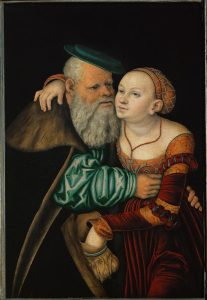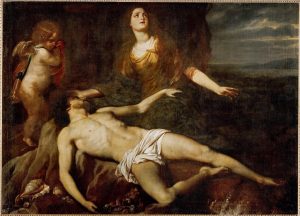Chapter 4: Young and Broken Hearts
We wrapped up Chapter 3 with samples of art focusing on domestic and passionate love. Even today, audiences clamor for portraits of passionate amour (French for love). Passion promises a great deal. All too often, it leaves destruction in its wake. The arts of many cultures probe the distress left behind by passion’s betrayal. Consider this satirical portrait of a an apparently loving couple by Lucas Cranach the Elder. Notice the title. What is Cranach revealing to us? Notice the hands!
 |
| Lukas Cranach, the elder. (1531). The Uneven Couple. Tempera on Beech. |
Leander’s Fatal Passion
Wise lovers protect themselves from the damage love can do. But many lovers are not so wise.
The tale of Hero and Leander derives from ancient Greek mythology. Hero, a priestess of the goddess Aphrodite, lived in a tower devoted to the goddess. Each night, her lover, Leander, would swim across the Hellespont, a narrow strait connecting the Black and Mediterranean Seas. Hero would burn a lamp in her window to guide Leander to her. One night, however, the lamp blew out and Leander drowned.
 |
| Jan van den Hoecke. (1637). Hero Bewailing the Death of Leander. Oil on canvas. |
In 1829, the great English poet John Keats stood before a painting that portrayed the cost on unwise love. His poetic imagination was stirred and he composed a sad Sonnet.
The tale of Hero and Leander derives from ancient Greek mythology. Hero, a priestess of the goddess Aphrodite, lived in a tower devoted to the goddess. Each night, her lover, Leander, would swim across the Hellespont, a narrow strait connecting the Black and Mediterranean Seas. Hero would burn a lamp in her window to guide Leander to her. One night, however, the lamp blew out and Leander drowned.
John Keats. (1829). On A Picture Of Leander
Come hither all sweet Maidens soberly
Down looking aye, and with a chasten’d light
Hid in the fringes of your eyelids white,
And meekly let your fair hands joined be,
As if so gentle that ye could not see,
Untouch’d, a victim of your beauty bright,
Sinking away to his young spirit’s night,
Sinking bewilder’d ‘mid the dreary sea.
‘Tis young Leander toiling to his death.
Nigh swooning he doth purse his weary lips
For Hero’s cheek, and smiles against her smile.
O horrid dream! see how his body dips
Dead-heavy; arms and shoulders gleam awhile;
He’s gone; up bubbles all his amorous breath!
Keats calls upon young lovers to reflect on Leander’s sodden corpse, a gruesome reminder of the perils into which unchecked passion can lead one. The story comes to us indirectly from a poem composed in Latin by the Roman poet Ovid, The Heroides. Our next cautionary tale is found in a work by Ovid that had enormous influence on the development of European culture.
References
Cranach, Lukas the Elder. (1531). The Uneven Couple. [Painting]. Vienna: Museum of the Visual Arts. WikiArt https://www.wikiart.org/en/lucas-cranach-the-elder/the-old-man-in-love-1537
Keats, J. (1829). On a picture of Leander. Hood, T. [Ed.]. The Gem, A Literary Annal. Allpoetry https://allpoetry.com/Sonnet.-On-A-Picture-Of-Leander
van den Hoecke, Jan. (1637). Hero Bewailing the Death of Leander [Painting]. Vienna, Austria: Kunsthistorisches Museum. https://www.khm.at/en/artworks/hero-mourning-leander-934
a 14-line lyric poem that explores a theme in stanzas with a thematic turn either between lines 8 and 9 (Petrarchan/Italian Sonnet) or between lines 12 and 13 (Shakespearian/English Sonnet).
